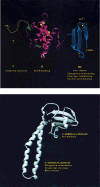Transcription elongation factor SII
- PMID: 10723030
- PMCID: PMC3367499
- DOI: 10.1002/(SICI)1521-1878(200004)22:4<327::AID-BIES3>3.0.CO;2-4
Transcription elongation factor SII
Abstract
RNA chain elongation by RNA polymerase II (pol II) is a complex and regulated process which is coordinated with capping, splicing, and polyadenylation of the primary transcript. Numerous elongation factors that enable pol II to transcribe faster and/or more efficiently have been purified. SII is one such factor. It helps pol II bypass specific blocks to elongation that are encountered during transcript elongation. SII was first identified biochemically on the basis of its ability to enable pol II to synthesize long transcripts. ((1)) Both the high resolution structure of SII and the details of its novel mechanism of action have been refined through mutagenesis and sophisticated in vitro assays. SII engages transcribing pol II and assists it in bypassing blocks to elongation by stimulating a cryptic, nascent RNA cleavage activity intrinsic to RNA polymerase. The nuclease activity can also result in removal of misincorporated bases from RNA. Molecular genetic experiments in yeast suggest that SII is generally involved in mRNA synthesis in vivo and that it is one type of a growing collection of elongation factors that regulate pol II. In vertebrates, a family of related SII genes has been identified; some of its members are expressed in a tissue-specific manner. The principal challenge now is to understand the isoform-specific functional differences and the biology of regulation exerted by the SII family of proteins on target genes, particularly in multicellular organisms.
Copyright 2000 John Wiley & Sons, Inc.
Figures


References
-
- Sekimizu K, Kobayashi N, Mizuno D, Natori S. Purification of a factor from Ehrlich ascites tumor cells specifically stimulating RNA polymerase II. Biochemistry. 1976;15:5064–5070. - PubMed
-
- Jones KA. Taking a new TAK on tat transactivation. Genes Dev. 1997;11:2593–2599. - PubMed
-
- Agarwal K, Baek KH, Jeon CJ, Miyamoto K, Ueno A, Yoon H. Stimulation of transcript elongation requires both the zinc finger and RNA polymerase II binding domains of human TFIIS. Biochemistry. 1991;30:7842–7851. - PubMed
-
- Yoon HS, Sitikov AS, Jeon CJ, Agarwal K. Preferential interaction of the mRNA proofreading factor TFIIS zinc ribbon with rU-dA base pairs correlates with its function. Biochemistry. 1998;37:12104–12112. - PubMed
Publication types
MeSH terms
Substances
Grants and funding
LinkOut - more resources
Full Text Sources
Other Literature Sources
Molecular Biology Databases

